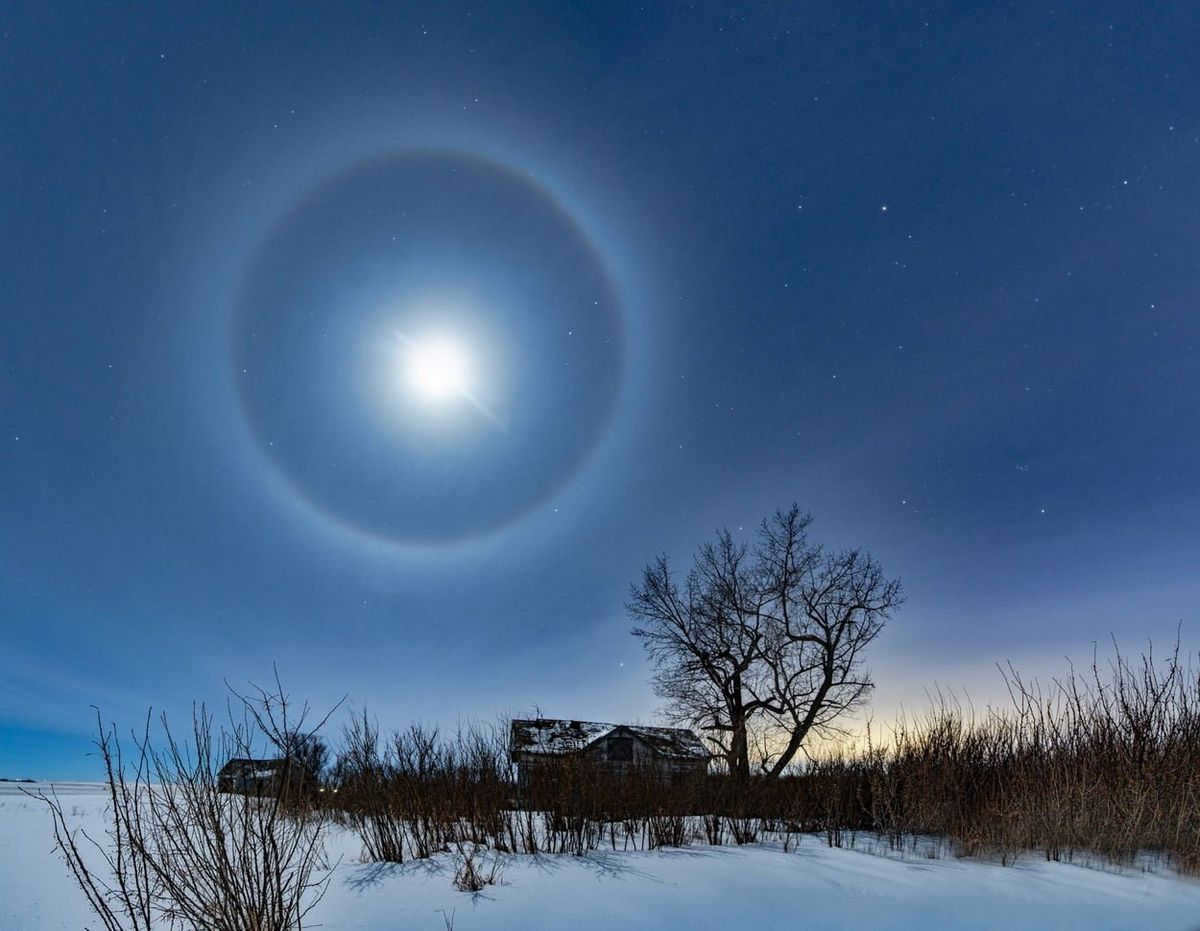
While numerous lunar events occur within a single night, one particular lunar phenomenon is much less elusive: the moon’s glowing rings.
These luminous white rings, also referred to as lunar halos or simply halos, can manifest at any point on the lunar calendar and during any season, particularly in winter. However, if you desire to witness this spectacle, you must disregard the cardinal rule of stargazing: refrain from observing the stars in cloudy conditions. Lunar halos are in fact caused by thin, feather-like clouds with layered formations, as well as the refraction and reflection of moonlight by the ice crystals contained within them.
In this article, we will delve into this extraordinary lunar display and the optimal circumstances for observing it.
Optimal atmospheric conditions for the formation of rings
Similar to rainbows, lunar halos occur when light interacts with water particles suspended in the atmosphere. These water particles are frozen and are present in specific types of clouds – perispheric and peristo-layered clouds. These unique clouds, which are located approximately 6 kilometers above us, can be found in areas where temperatures are so cold that water cannot exist in its liquid form.
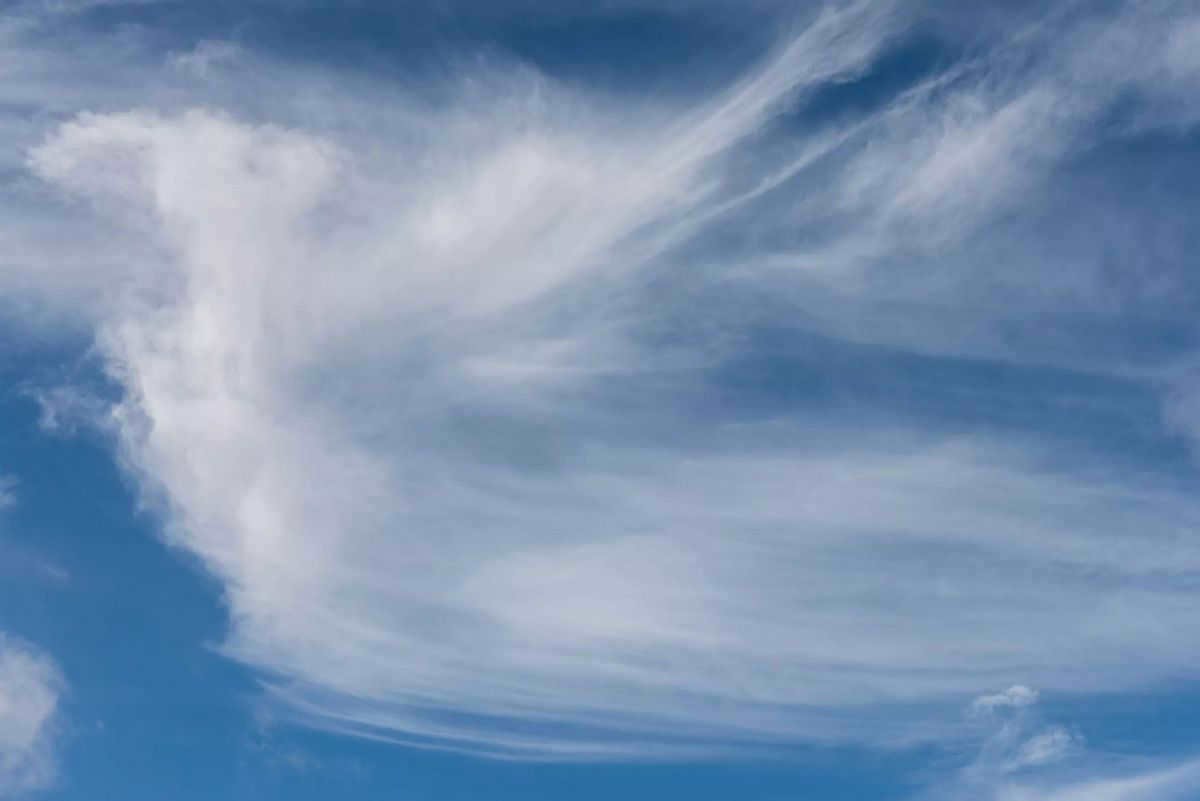
Thin and puffy clouds floating high in the blue sky create an enchanting sight as they form a delicate veil around the moon and the sun.
Tim Grist / Getty Images
It is ideal for the sky to have a clear appearance, with a delicate layer of feathery clouds. If thicker clouds are present at lower altitudes, they will obscure the halo effect from being visible.
As the moonlight passes through the feathery clouds, it encounters the countless tiny ice crystals within the clouds. These crystals cause the light to refract, or bend and change direction, as it enters each individual crystal. Subsequently, the light is refracted again as it emerges from the crystal on the other side.
The amount of bending of moonlight depends on the size and shape of the crystal itself. In the case of lunar halos, the ice crystals are small hexagonal columns that are less than 20 microns in size. These crystals deflect light at an angle of 22 degrees from its original path, which is why lunar halos are often referred to as “22-degree halos”.
The dispersion of light in all directions, including top, bottom, side, and diagonal, from the Moon creates the distinctive round shape of lunar halos.
What Causes the Phenomenon of a Ring Around the Moon and How Does It Occur?
The appearance of a ring around the moon, also known as a halo, is caused by the presence of ice crystals in the atmosphere. These crystals must be oriented and positioned in a specific way in order for the halo to be visible to an observer.
When light from the moon reflects off these ice crystals, it creates a halo effect. However, in order for the halo to be seen, the reflected light and the direct light from the moon must intersect at a precise angle of 22 degrees in the observer’s eye.
It is important to note that the formation of halos around the moon or the sun is a personal experience. This means that each observer sees their own unique halo, as it is formed by the ice crystals present in their immediate vicinity. The composition and arrangement of these ice crystals can vary from person to person, resulting in individual differences in the appearance of the halo. Factors such as personal height and the observer’s position also play a role in how the halo is perceived.
Due to the sun’s immense brightness, which is 400,000 times greater than that of the full moon, the ring surrounding the moon tends to appear faint. In fact, it is so dim that the color-detecting cells in our eyes often fail to perceive its light. As a result, lunar halos often appear as a milky white color, as white light is a combination of all visible colors. (3)
As for the area of the sky between the ring and the moon, it typically remains dark. This is because none of the ice crystals reflect light at angles smaller than 22 degrees.
The ring will continue to be visible as long as the periwinkle clouds form a veil beneath the Moon.
How are solar halos related to the Sun?
Solar halos are formed around the Sun when a similar process occurs during the daytime. Unlike the lunar rings, these halos have a reddish hue within their ring and a bluish hue outside of it.
Something reminiscent of a moon halo
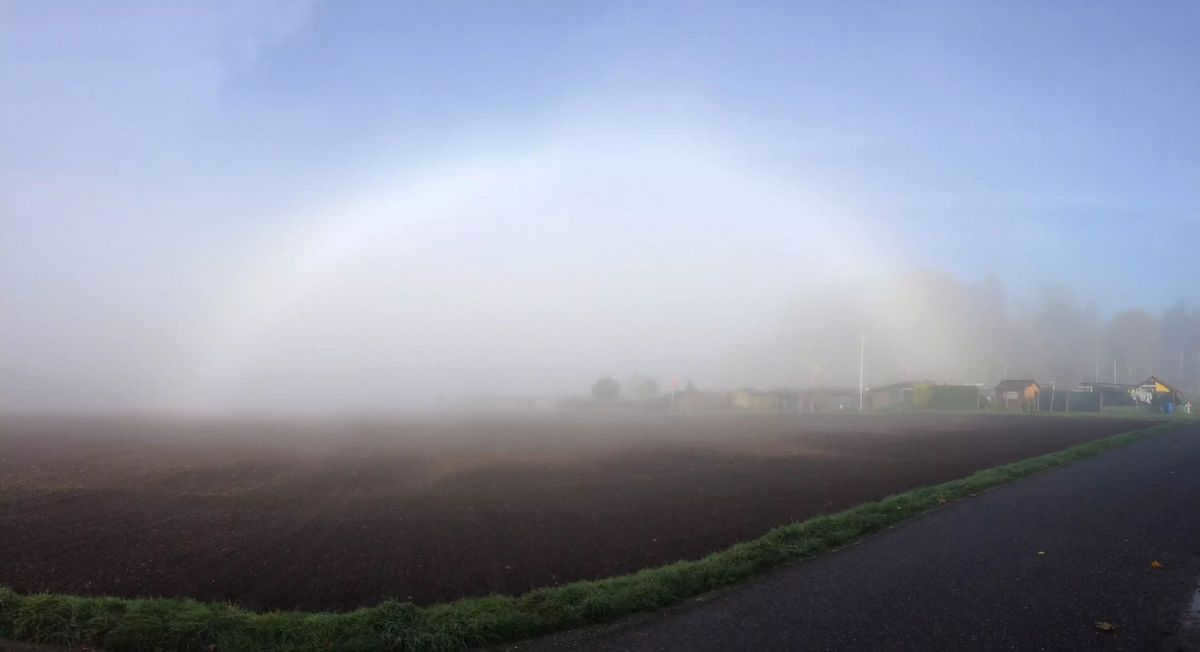
A misty rainbow is a representation of a “semi-circle.” Bridget Blettler/Getty Images
There are other rings that surround the moon besides lunar halos. These rings are often mistaken for lunar coronas, but the latter are discs with rainbow colors that form when moonlight (or sunlight) interacts with water droplets in fog. Coronas also tend to form a tighter circle around the Moon, with a radius of 10 degrees instead of 22 degrees.
Misty rainbows, like lunar halos, are white in color but appear low in the sky. They are also formed by water droplets, particularly those that are very small, such as fine fog or haze.
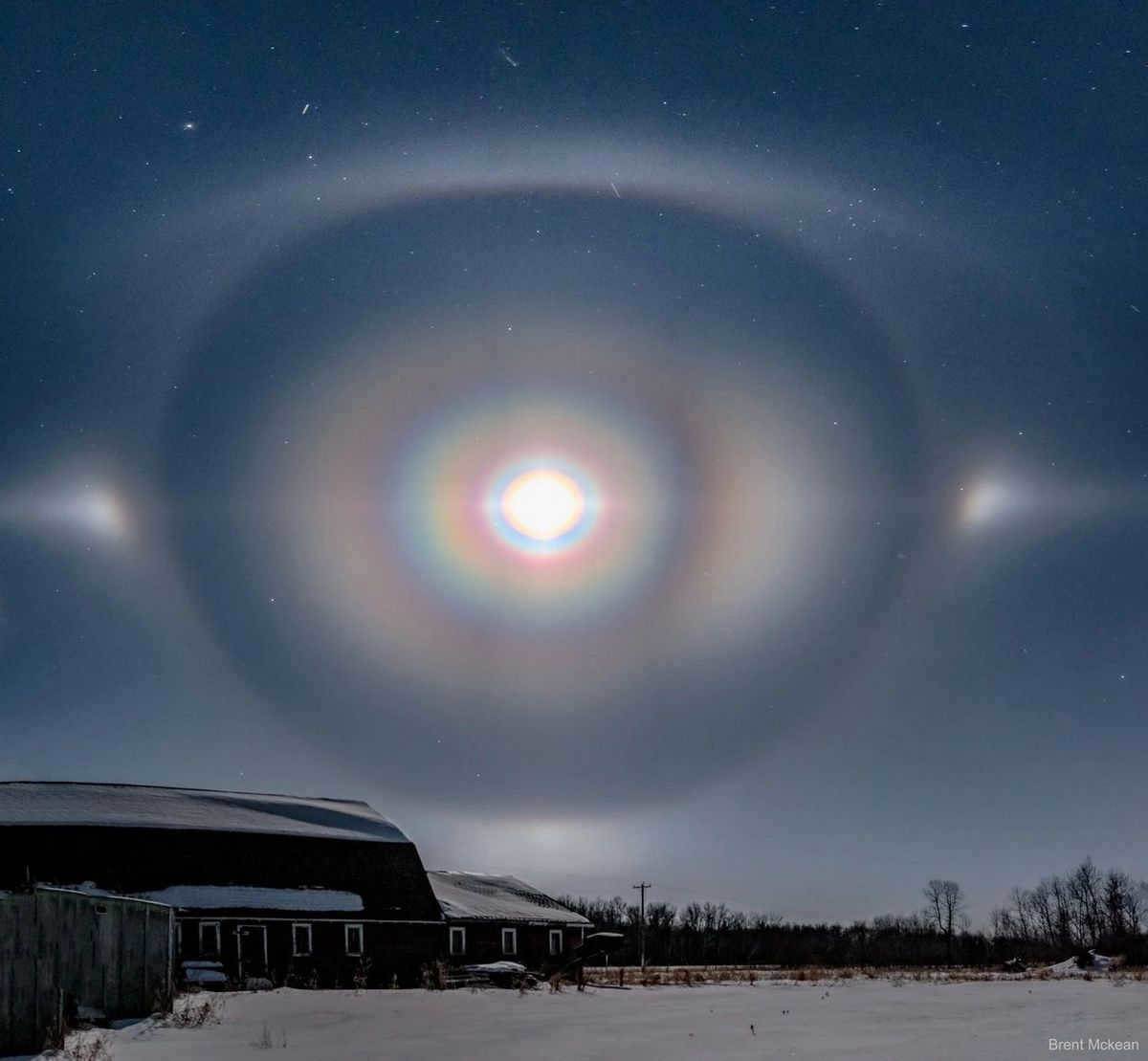
A remarkable occurrence took place in Manitoba, Canada during the winter of 2020. The moon was not only encircled by a luminous halo, but also accompanied by a corona, illusory moons, and tangent arcs. This truly rare spectacle outshines many other natural phenomena. (4)
With a career spanning over 15 years, he has established himself as an esteemed environmental and science journalist. His writings cover a broad range of subjects including science, culture, space, and sustainable development. He is a freelance author for the website “Knowledge is Light”.
The incredible and diverse nature is not only characterized by its wide array of plant and animal species, but also by its extraordinary, one-of-a-kind, and awe-inspiring phenomena. While many of these phenomena can be scientifically explained, there are still some that remain mysterious, such as the halo.
In ancient times, the halo, along with other unexplained occurrences, was often attributed mystical meanings and seen as a bad omen, particularly when it took on a cross shape or appeared alongside multiple celestial bodies. For instance, in “The Tale of Igor’s Campaign,” it is mentioned that “four suns shone over the Russian land” just before the Polovtsians attacked and captured the prince. This was interpreted as a sign of impending doom.
Unbelievable Wonders of Nature
There are numerous natural phenomena that leave ordinary people puzzled and amazed. Here is a brief explanation of some of the most fascinating ones.
The Northern Lights, also known as Aurora Borealis, is a mesmerizing display of luminescence that occurs when solar-charged particles interact with the upper atmosphere. This breathtaking phenomenon is predominantly found in latitudes closer to the poles.
Shooting stars, which are luminous dots gliding across the night sky, are actually small stones or particles of cosmic substances. This captivating spectacle can be observed on a clear night, with a bright flash occurring when these pieces penetrate the Earth’s atmosphere. During certain periods, an abundant extravaganza known as “star rain” can also be witnessed.
There are other natural processes that can occur as well, such as the optical phenomenon known as a halo, the creation of pearlescent and double-convex clouds (which are extremely rare), and even instances of precipitation with living creatures, like the phenomenon of frog and fish rain.
What is a halo?
A halo is the most common occurrence in which luminous circles appear around celestial luminaries in the sky, often resembling “false suns,” various pillars, and crosses.
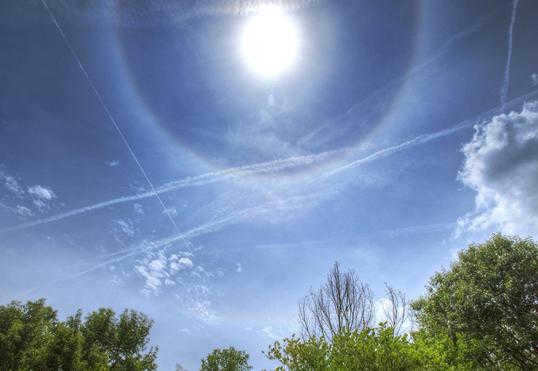
However, in most situations, it is simply a regular halo of light. It can be visible for multiple days in regions with moderate latitudes.
The appearance of a halo, in contrast to other phenomena, is grounded in scientific principles.
The creation of a remarkable circle of light surrounding the sun is explained by the refraction of sunlight in ice crystals present in clouds and fog. There is a differentiation between a solar halo and a lunar halo.
Variety of forms and species
In general, a halo refers to a specific group of phenomena occurring in the atmosphere, specifically optical phenomena.
The following are some of the most well-known manifestations of halos:
- Rainbow circles located behind the disk of the Moon or the Sun, with angular radii of 22° and 46°;
- “False suns” (parhelia) or bright spots, often iridescent, appearing on either side of the luminaries at distances of 22° and 46°;
- Circum-zenithal arcs;
- Parhelion circles, which are white horizontal circles passing through the Sun’s disk;
- Pillars, which are vertical segments of the white circle and, when combined with the parhelion circles, form a white cross.
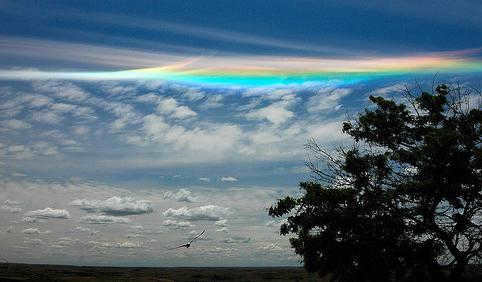
Halo formations occur when light rays are bent, while white halos are created through reflection.
Halo occurrences are occasionally mistaken for wreaths, as they share a similar visual appearance, but wreaths are actually produced through diffraction.
Halos typically manifest as circular formations encircling the Sun. Furthermore, the inner edge of the circle is illuminated and exhibits a slightly reddish hue.
Subsequently, the coloration gradually transitions to a pale yellow, followed by a greenish tint, and even a blue-violet shade towards the outermost portion of the ring.
Occasionally, the complete circle may not be visible, with only a segment of it being apparent (typically the upper segment).
Additionally, there are luminous arcs that intersect with either the upper or lower section of the circular illumination.
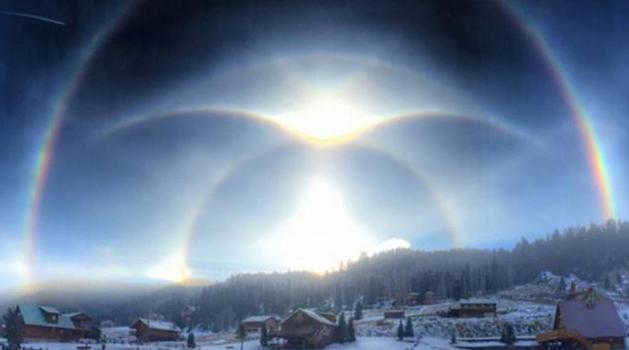
It is not very common to observe a halo, which is a colorless circle that stretches across the moon or sun and runs parallel to the horizon. Occasionally, when this halo intersects with certain points, it creates light spots known as “false suns”. These spots are incredibly radiant and brilliant, often resembling a second sun.
Pillars and crosses: the phenomenon of their occurrence
Halos are extraordinary natural phenomena that take on a variety of peculiar shapes. They become visible when there are perispherical clouds of light situated between the observer and the celestial bodies, or when ice crystals are suspended in the air as individual elements with a precise configuration (such as a hexagonal prism).
It is not uncommon to observe a halo in the form of a vertical column when the celestial bodies illuminating the Earth are in close proximity to the horizon (either above or below it). This particular shape is attributed to the reflection of rays specifically from the horizontal facets of ice crystal flakes in the atmosphere. Occasionally, two such columns can be seen on either side of the sun, forming part of an incomplete halo arc, where only a portion of the circle is visible.
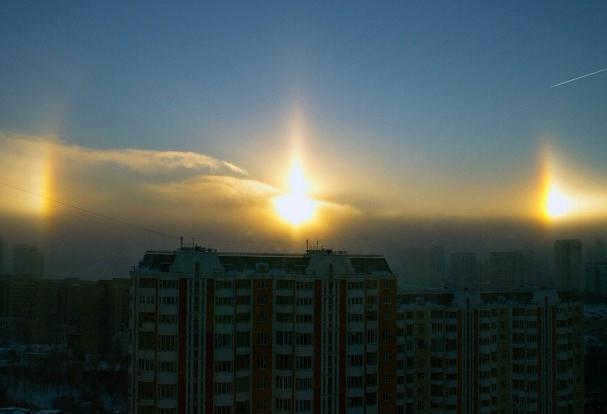
There is a wide range of phenomena related to halos, which can be attributed to the great variety of ice crystal forms and their diverse distribution in the atmosphere.
What can halo phenomena indicate? Signs and omens
The appearance of different types and shapes of halos can provide insights into upcoming weather changes within the next few hours.
When a complete rainbow circle (sometimes barely visible) forms near the sun or moon, usually accompanied by layered clouds in the atmosphere, it often signifies the approach of a warm front or cyclone. Windy weather is expected to follow in approximately 12-20 hours. The brightness of the halo weakens as the clouds thicken.
There are circular formations surrounding the Sun (Moon) that lack iridescent hues, known as “pseudo-suns” or pillars. These optical phenomena are visible during clear weather conditions. This occurrence indicates the continuation of stable and sunny weather, and during winter, it suggests the presence of prolonged and intense frost.
In unstable air masses and in the peripheral and rear regions of anticyclones, partial ring-shaped formations appear near celestial bodies. This indicates that the weather will be changeable, with strong winds and heavy precipitation.
Large white circles with a diameter visible at a 92° angle near the Sun or Moon during winter are indicative of a powerful anticyclone or high-pressure system in the vicinity. During such instances, we can expect relatively stable weather conditions, with weak winds and severe frosts.
There are numerous phenomena that cannot be explained by science-based theories and explanations. Instead, people can only admire the stunning sights they witness.
Halo is a vibrant and comprehensible natural phenomenon.
What is the cause of the large circular halo around the moon? A thorough investigation led to the most satisfactory answer.
Answer by Jika[guru].
The phenomenon of a ring appearing around the moon at night can be quite perplexing. We know that there are no actual rings orbiting the Moon in outer space, so why do we see this ring? The answer lies in our atmosphere and the optical effects it creates. If you look closely, you’ll notice that the ring is not purely white. It actually resembles a faint, circular rainbow with a light red color on the inside and a pale blue color on the outside.
This ring, also known as a halo, is formed when light is refracted by ice crystals in high, cold, periwinkle clouds. Each hexagonal ice crystal acts like a tiny prism, catching rays of white light and breaking it down into all the colors of the spectrum.
The refracted moonlight takes on the shape of a circle because the ice crystals collect the light into a cone. If you extend both arms forward, the width of the ring will usually be about the size of two of your fists. The size of the ring depends on the amount of light captured by the crystals. Most moonlight is caught and refracted at a 22° angle, forming a small cone. However, larger halos with a 46° angle can occasionally occur when moonlight passes through the sharper edges of the crystals.
Interestingly, this halo around the Moon is often seen as a sign of rain, and it usually appears on cloudy nights.
In addition to its unique optical properties, the Moon itself has a fascinating origin story. Scientists believe that during the chaotic period of the Solar System’s formation, fragments of rock circled the newborn Sun. These fragments collided and merged, eventually leading to the formation of our solar system with its nine planets, over 50 satellites, and various asteroids, meteorites, meteors, and comets.
Our Moon likely had a dramatic and violent birth. The young Earth was extremely hot, with molten rocks flowing across its surface like rivers of lava. It is believed that a small protoplanet named Theia, roughly the size of Mars, formed near Earth and eventually collided with our planet. The impact caused a massive explosion, sending streams of hot lava into space.
Some of this volcanic material returned to Earth, while the majority remained in space and formed a hot rock that orbited the Earth. Over time, this rock cooled and shaped into the familiar white-gray Moon we know today.
Intriguingly, computer simulations of the collision have shown that in 9 out of 27 scenarios, two satellites were formed. One of these satellites survived and became the Moon we see today, while the other had an orbit even closer to Earth. However, due to the Earth’s gravitational forces, the orbit of the second satellite became unstable and it eventually fell to the Earth’s surface, leaving no trace behind.
If these theories are correct, it means that we may be walking on remnants of the Moon’s former sibling every day.
Response from Ewgeny gasnikov [guru].
A celestial phenomenon known as a halo can be observed around the Moon, indicating a change in weather to colder temperatures.
Similarly, light circles can also be seen around the Moon and the Sun.
Here are some alternative descriptions:
A fascinating optical phenomenon that occurs in the atmosphere.
A natural occurrence that allows one to witness the presence of “three” Suns simultaneously.
Bright circles, arcs, pillars, and spots that appear around or near the disks of the Sun and Moon.
A luminous ring that encircles celestial bodies.
Light circles that form around the Moon.
An optical phenomenon that manifests around a celestial body.
Rainbow rings that encompass the Moon.
The term “lunar halo” rhymes with “lard”.
Referring to either a solar or lunar halo.
These circles and spots can be observed around or near the disks of the Sun or Moon.
White or iridescent light circles that are visible around or near the disks of the Sun and Moon.
“Aurora Borealis” encircling the Moon
A lunar halo resembling mold
An optical occurrence surrounding a celestial body
A natural phenomenon where one can witness the presence of “three” Suns simultaneously.
Compare to gibalo, a contraption for curving arcs, edges, and tracks: a circular or grooved section is carved into sturdy wood; a placha, heated in a steam apparatus or subterraneanly, with a substantial blaze, is placed within a halo and firmly fixed.
Halo is a captivating and extraordinary natural occurrence that manifests as a radiant ring encircling a brilliant light source. While it is commonly observed around the sun, it can also be seen encircling the moon (known as a lunar halo) and other intense light sources like streetlights. There is a diverse range of halo types, but they all share a common origin – ice crystals. These crystals are predominantly found in perispheric clouds situated at an altitude of 5-10 km. However, they can also be found closer to the ground level, producing an ethereal “aura” around streetlights or a halo around an individual’s head.
The appearance and form of the halo rely heavily on the shape and placement of the ice crystals, and under certain circumstances, it can even take on the appearance of a parhelion (a false sun). When light passes through these ice crystals, it is both refracted and reflected at various angles. The size of these angles is determined by the position of the crystals. If the halo is observed under well-lit conditions, it may exhibit a rainbow-like pattern. In reality, this pattern is simply the result of the refracted light being decomposed into a spectrum. In low light, the “rainbow” may not be visible to the human eye, although it is indeed present.
Disks surrounding the sun can appear not only due to refraction on ice crystals, but also as a result of water droplets forming a cloud or fog. These disks are known as wreaths. They can be differentiated from the halo by their significantly smaller radius, which does not exceed 5% of the halo’s radius.
It would not be surprising for me to say that in the past our ancestors attributed mystical properties to the halo around the sun and often considered its appearance in the sky as a negative sign.
Here are a few more photographs of the solar halo:
The halo around the sun is not limited to just one halo; there can be multiple.
Science of weather. Traditional methods for predicting weather based on the Moon.
Using the moon to forecast the weather.
Traditional weather omens based on the moon.
If the Moon appears with sharp ends during the summer month, it indicates clear weather, but if it appears with blunt ends, it indicates rain.
If a circle appears around the Moon at a close distance, it is a sign of rain tomorrow. In winter, if there are two dim reddish rings around the Moon, it indicates severe frost.
If there is a foggy circle around the Moon, it indicates a snowstorm.
If the Moon is covered in a faint haze, it suggests prolonged inclement weather.
If the circle is red, it indicates that there will be a strong wind, and during winter we can expect heavy snowfall. (A Moon with an expanding and turning red circle indicates a strong wind.)
If the Moon appears larger than usual and has a reddish color, it means that it will rain.
The pale color of the Moon is a sign of bad weather, and in winter it suggests heavy snowfall.
If the Moon is dazzling white, it means it will be cold, and if it is reddish, it indicates wind.
If there is a foggy circle near the Moon, it suggests a snowstorm. If the Moon is in a faint haze, it indicates a long period of inclement weather.
If during a full moon the Moon is light and clear in color, it suggests good weather, and if it is dark and pale, it suggests rain.
If the Moon is clear and has round horns in summer, it suggests good weather, and in winter, it suggests cold weather.
If the shape of the Moon’s disk is distorted, it suggests a dry, cloudy day.
If a circle forms around the Moon during the full moon, it suggests rain at the end of the month.
If there is windy weather at the beginning of the month, it will continue throughout the month.
If there is inclement weather on the fourth day of the Moon’s cycle, it will persist throughout the following month.
If the young Moon is curved less than usual in summer, it suggests rain, and in winter, it suggests snow during the month.
If the new Moon appears during windy weather, it suggests wind throughout the month, and if it is washed by rain, there will be no inclement weather.
If the young Moon appears “thick” and has a yellow color, it suggests wet weather, and if it is light and thin, it suggests clear weather during the month.
If circles form around the Moon close to it, rain will come the next day (soon, but not for a long time); if they are far away, rain will come in 1-3 days (not soon, but for a long time); in winter, there will be a blizzard.
A Moon with a clear circle around it that expands and disappears portends clear weather.
If the Moon has two or more such circles, or only one but vague and obscure, there will be frost.
If the circle around the Moon is red, it indicates that a strong wind will follow, and in winter, we can expect extremely heavy snowfall.
A Moon with an expanding and turning red circle indicates a strong wind.
A Moon with a circle adjacent to it suggests rain coming very late, while a circle that is distant suggests rain coming soon.
There are no circles around the young (new) Moon; if a circle appears around the Moon during the full moon, there will be inclement weather by the end of the month; if a circle appears during the waning phase, there will be inclement weather before the new moon.
If the sky begins to be covered with a film of clouds (“to let the horses”) and the Moon is surrounded by a circle, it suggests inclement weather.
If the Moon has ears (spots on both sides of the horizon), it suggests frost.
If the Moon’s phase change (birth of the Moon) occurs in the morning, the weather will be warm, and if it occurs in the evening, it will be cold.
The weather at the birth of the Moon will last for the first half of the month; the weather at the full moon will last for the second half.
When the Moon has horns pointing upwards, with the lower one being steep and the upper one flat, the first half of the month will be windy in summer and cold in winter;
If the upper horn is steep and the lower one is hollow, the same omen applies to the second half of the month.
If the Moon is on its hooves, it suggests cold weather, and if it is on its back, it suggests warmth, rain, or snow.
The new moon is gentle, and it will rain throughout the month.
After the birth of the Moon, the weather changes within seven days.
A clear round-horned Moon in summer suggests rain, and in winter, it suggests cold weather.
Two faint reddish rings appearing around the Moon are a sign of a strong frost.
If there is a ring around the Moon, the weather will be cold and severe.
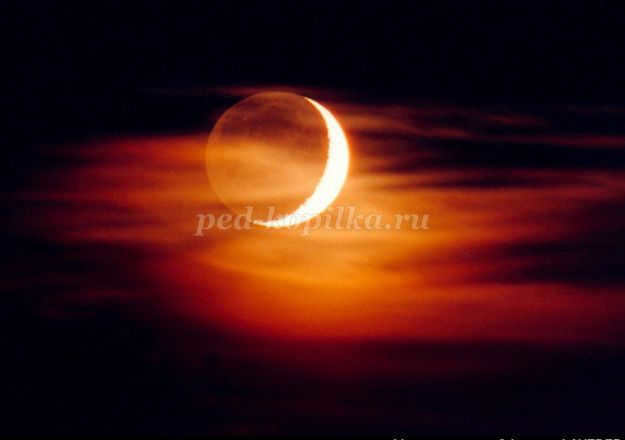
Articles recommended for you on this subject
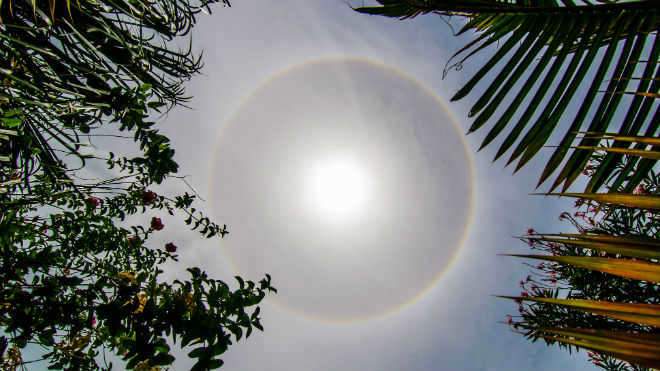
The phenomenon of a halo is truly one of nature’s most breathtaking marvels. Those fortunate enough to witness it are left in awe of the stunning beauty that nature has created. But what exactly is a halo, and how does this extraordinary glow form in the sky? In this article, we will delve into these questions and seek to uncover the secrets behind this mesmerizing phenomenon.
A halo is a natural phenomenon that occurs when light is scattered by ice crystals in the atmosphere, creating a ring-shaped iridescent glow around the Sun or Moon. The primary source of ice crystals for halo formation is Cirrostratus clouds, which contain numerous small ice crystals. The shape and size of a halo can vary depending on the type of ice crystals and atmospheric conditions.
This mesmerizing spectacle is often observed during the transition of a cold front, when there is an abundance of ice in the atmosphere. While halo can be seen at any time of the year, it is most commonly observed during cold weather when snow or sleet is falling. Additionally, halo can be spotted at higher altitudes, such as on mountain tops where temperatures are low enough for ice crystals to form in the atmosphere.
The appearance of it can be similar to that of a circular rainbow, with arcs or circles, and it can even transform into shapes that are beyond imagination.

The reason behind this occurrence is quite simple. This atmospheric event takes place when beams of light get bent due to ice crystals. In order for a beautiful glowing effect to form around a light source, these tiny crystals need to be present in the lower layers of the atmosphere or in the form of perispheric clouds. The light gets reflected off the surfaces or the base of the ice columns: as they descend, they twirl, vibrate, or stay still in the air. Depending on their orientation, the beams of light refract at different angles. Sometimes, you may even spot a second bright halo and false “suns” or “moons” appearing alongside it. According to the principles of physics, these false celestial bodies always appear at the same elevation above the horizon as the actual star or satellite.
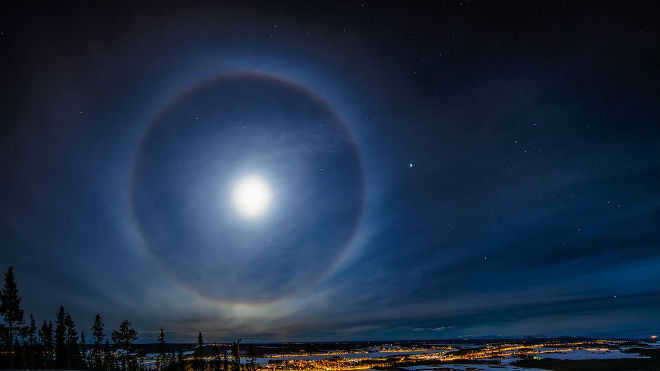
During a full moon, it is common to see circles around the Moon. A mesmerizing sight, the glowing disk is especially captivating in frosty weather. Many fans of nighttime “hunting” have captured the ring around the Moon, illuminating the stars, in numerous pictures.
Origin
The word “halo” comes from the Greek word meaning “circle” or “disk”. This unique optical phenomenon has always garnered a lot of attention. In ancient times, the appearance of multiple copies of the Sun, bright arcs, or light crosses in the sky caused genuine fear. People believed that the halo effect was a sign of destructive wars, famine, and great misfortune.
In July 1794, the people of St. Petersburg were treated to an extraordinary celestial spectacle. Renowned astronomer T. Lovitz documented this event as the simultaneous manifestation of twelve arcs and circles in the sky, with nine of them displaying a stunning array of colors.
Amidst the siege of Magdeburg by King Charles V of Spain’s forces, a truly miraculous occurrence took place: three suns suddenly illuminated the city. Recognizing this as a sign of warning, the fearful ruler abandoned his plans for a decisive attack and lifted the siege.
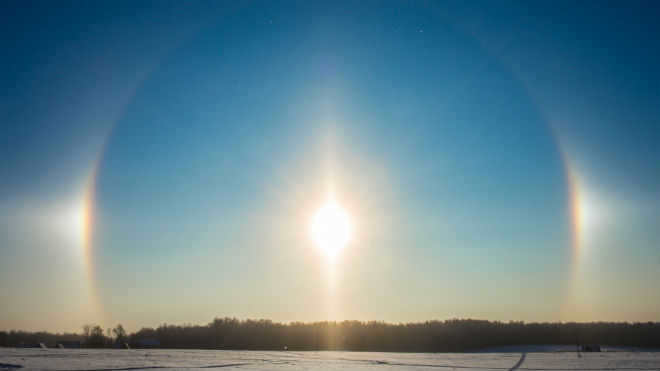
Following Napoleon’s defeat, the French observed the emergence of a radiant spot above the Sun. Its shape bore resemblance to the triangular hat worn by the emperor. The people associated this celestial sign with Napoleon’s return from exile on St. Helena.
French scientist C. Flammarion extensively studied the records of halo occurrences and concluded that this phenomenon is directly linked to significant events.
Shakespeare and Jack London mentioned prophecies connected to the appearance of this mysterious glow in their works.
It is well-known that the appearance of a luminous circle in the sky is a precursor of inclement weather. Blizzards and storms often follow such a phenomenon.
Causes of the Formation of a Halo
The structure and behavior of ice crystals in the upper atmosphere are responsible for the shape and appearance of a halo. When light passes through these crystals, it bends and separates into different colors, creating a circle with a similar color pattern to a rainbow, but with less intensity. In order for a halo to appear on a winter day, three specific conditions must be met:
Many individuals are curious about the presence of rainbows during the winter season. Witnessing a “winter rainbow” is considered quite fortunate. While the refraction of light in water droplets is enough to create a rainbow during the summer months, a winter rainbow can only be formed when the sun shines brightly, there is a significant frost, and the atmosphere is highly humid.
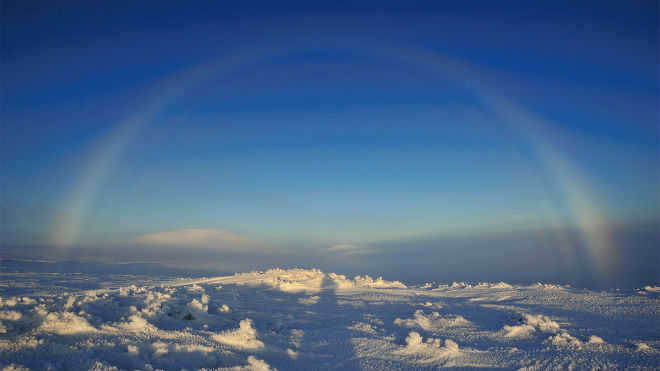
During a severe freeze, ice crystals develop near the Earth’s surface, producing the mesmerizing phenomenon known as “diamond dust” that sparkles and glimmers in the sunlight.
In Antarctica, halos are frequently observed due to the optimal conditions provided by the high slopes. Intense winds carry snow clouds, leading to the formation of crystals that reflect light and form peculiar circles in a variety of colors.
Various Types of Halos
There is a wide array of over 150 different types of this enigmatic phenomenon. The most commonly observed halo is the 22-degree halo, which appears in close proximity to the source of light:
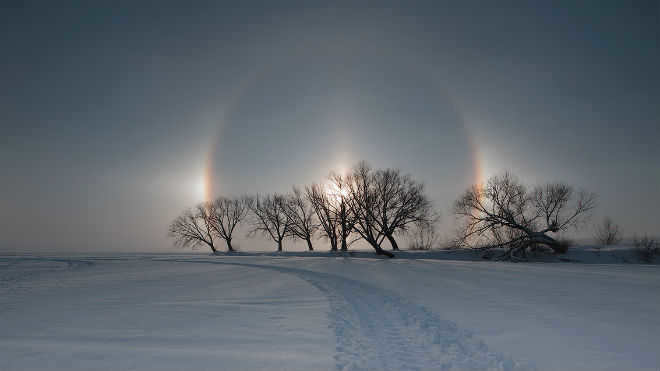
It is uncommon to find arcs and circles positioned at a 46-degree angle in relation to the Sun:
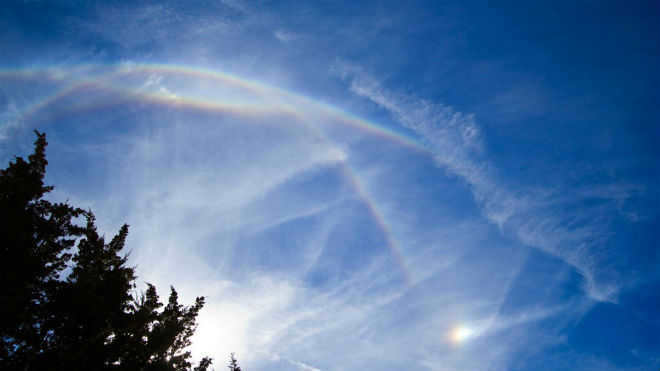
One of the most captivating phenomena in nature are the halos that fill the entire expanse of the sky. The dominant colors observed in these halos are white, red, and orange. These circular patterns of light that surround the Sun are actually a blend of various hues. Occasionally, a complete spectrum halo can be seen.
A particular type of halo, known as a parhelion, resembles a disk-shaped rainbow with apparent satellite images of the Sun. This striking phenomenon is hard to miss in the sky, whether it be during the day or night.
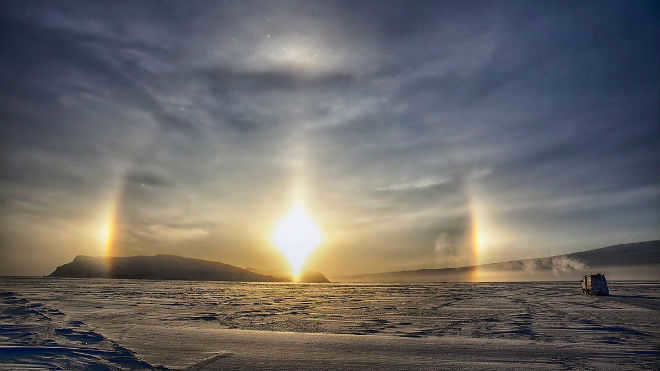
This optical phenomenon occurs due to the slow descent of ice crystals, which in this particular case take on the appearance of plates rather than rods. These nearly weightless plates disperse horizontally through the air without flipping over. The refraction of light through these irregularly arranged particles creates such a remarkable effect. Legends have been woven around parhelia, comparing them to UFOs and other mystical phenomena, which have been reflected in various works of art.
One variation of parhelion is known as “antigelium” (or anti-sun), where a bright spot is visualized next to the Sun at the same height, creating the illusion of a second celestial body:
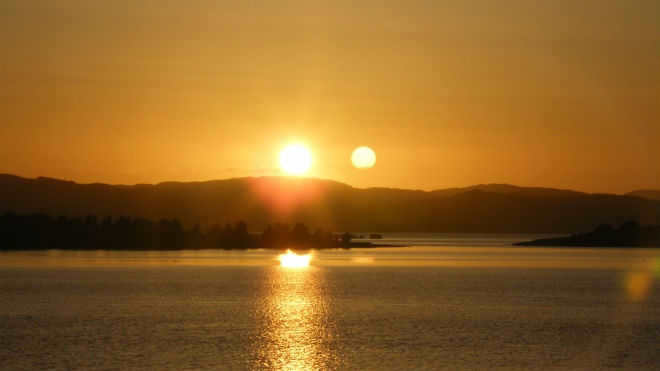
The solar pillar, as it is commonly known, has a rather peculiar appearance:
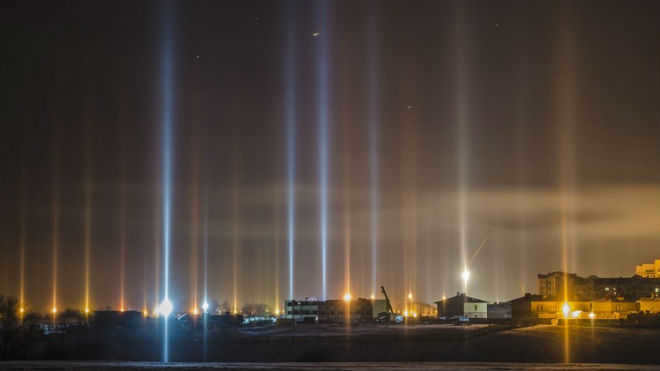
When a star rises or sets, the column typically extends upwards. On occasion, the column intersects with an arc, creating a cross shape in the sky. It appears particularly foreboding during sunset, adopting a vibrant crimson hue. Vertical columns are formed when crystals rotate around a horizontal axis, while horizontal columns revolve around a vertical axis.
When there are perispherical clouds present in the sky, it is occasionally possible to observe a zenith or “inverted” rainbow:
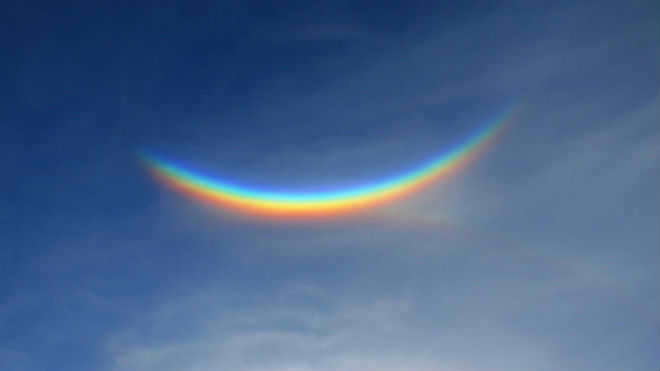
Occasionally, the luminous circle takes on a horizontal orientation rather than a vertical one. This phenomenon is referred to as a “subhalo.”
Meteorological conditions have a significant impact on the shapes and varieties of halos. Some of these can be so unexpected and peculiar that they leave individuals in a state of astonishment, eliciting emotions previously unknown. This accounts for people’s belief in the mystical power of this phenomenon.
Distinguishing the Solar Halo from the Rainbow
Although they may seem similar in appearance, the solar halo and the rainbow are distinct phenomena:
- A rainbow can only be observed when facing away from the sun, while a halo always surrounds the sun.
- While rainbows display a full spectrum of colors in their usual arched shape, the halo typically only shows shades of red and orange, with rare instances of the entire spectrum or a colorless halo. Additionally, the red end of the rainbow’s spectrum is located on the outer edge, while the purple hues are closer to the sun in a halo.
- Rainbows are formed through the refraction of light in water droplets, which remain constant and identical. In contrast, the appearance of a halo is dependent on ice crystals, which can vary and exhibit different movements.
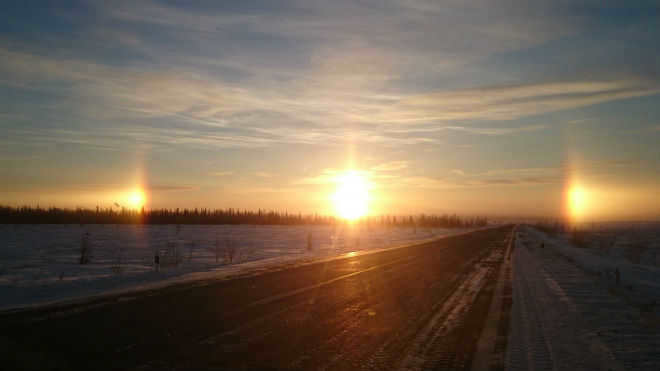
A halo in the sky is an extraordinary natural occurrence that bears a resemblance to enchantment and captivates with its extraordinary forms. Examining this phenomenon presents an opportunity to view it from a fresh perspective, to delve into the intricacies of nature, and to comprehend that these colorful circles are the product of optical illusions governed by the laws of physics. When observing a vibrant halo, it is crucial to prioritize safety by wearing a pair of sunglasses with a dark tint.

Believers in superstition often interpret solar halos as omens. In ancient times, our ancestors were more attuned to the signs of nature and could always decipher unusual phenomena as messages from above.
Interpreting Omens and Superstitions Surrounding Solar Halos
Solar halos occur when light is refracted, reflected, and scattered through icy particles in perispherical clouds. The sun’s rays pass through hexagonal crystals, causing them to bend at a 22-degree angle and creating a halo effect around the sun.
This refraction of light through ice particles separates the sun’s rays into different colors, resulting in a visible spectrum. This creates a perception of a rainbow, with red on the inside and a blue hue on the outside.
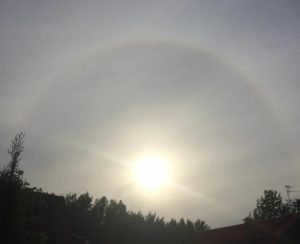
At times, there are luminous regions encircling the halos, giving the illusion of an additional sun emerging.
Interpreting the Significance of a Sun Halo
In ancient times, people lacked the scientific knowledge possessed by contemporary physicists, who can now capture photographs and provide scientific explanations for this natural phenomenon. Instead, ancient people relied on omens and superstitions whenever a halo appeared.
According to folklore, the halo around the sun could be used to predict future weather conditions. Inclement weather could be foretold by observing the halo.
It is commonly believed that when there is a ring around the sun, it indicates that rain is coming. From a scientific perspective, this phenomenon can be explained by the presence of high, fluffy clouds that refract the sun’s rays and are often associated with precipitation. Interestingly, even if the sky appears clear, the presence of a sun ring does not necessarily disprove the old saying.
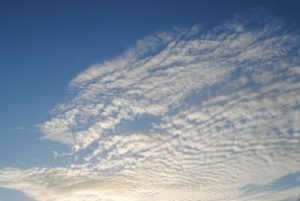
Feathery thin clouds have the ability to drift at altitudes exceeding 20,000 feet.
In addition, our ancestors held the belief that the appearance of a solar halo is a sign of imminent snowfall and extreme cold temperatures.
However, alongside these omens, there exist various superstitions surrounding the solar halo phenomenon. For instance, it was widely believed that the solar halo was actually a celestial sword made of fire. It was also believed that only a select few individuals had the ability to witness this phenomenon, and those fortunate enough to do so were said to be destined for great luck in the future.
Important! It is worth noting that there are multiple types of solar halos, each with its own distinct shape, color, and cause of formation.
The lunar halo and its mystical significance
The lunar halo is an intriguing phenomenon that occurs when the atmosphere contains numerous minuscule ice crystals, causing the sun’s rays to be reflected. These reflected rays then create a mesmerizing halo around the moon, captivating observers with its ethereal beauty.
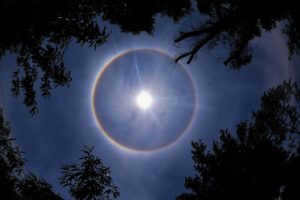
The halo around the moon is perceived by individuals as radiant spots positioned to the right or left of the celestial body, and on occasion in all four compass directions
In order for this phenomenon to manifest, it is imperative for the nighttime to be not only clear of clouds, but also exceptionally frosty. Quite frequently, the occurrence of a moon halo can be observed during an anticyclone, when frigid weather conditions persist for an extended period of time.
Researchers hold the belief that this natural phenomenon is a result of the interaction of atmospheric fronts. During winter, the moon’s halo serves as an indication of impending snowfall, while in summer it foreshadows rain. Additionally, folk beliefs view the halo surrounding the celestial body as a precursor of climate alterations.
One can easily explain this: even in today’s world, sudden climate change disrupts the normal way of human life. However, while modern technologies and advancements allow us to prevent or minimize the damage caused by natural disasters, in ancient times people had to rely on higher powers.
Final thoughts
The sighting of a solar halo is often associated with weather conditions. It is seen as a precursor to climate change and precipitation. In ancient times, people interpreted the halo as a bad omen and would try to alter their fate after witnessing such signs. Nowadays, there is a scientific explanation for this phenomenon.





